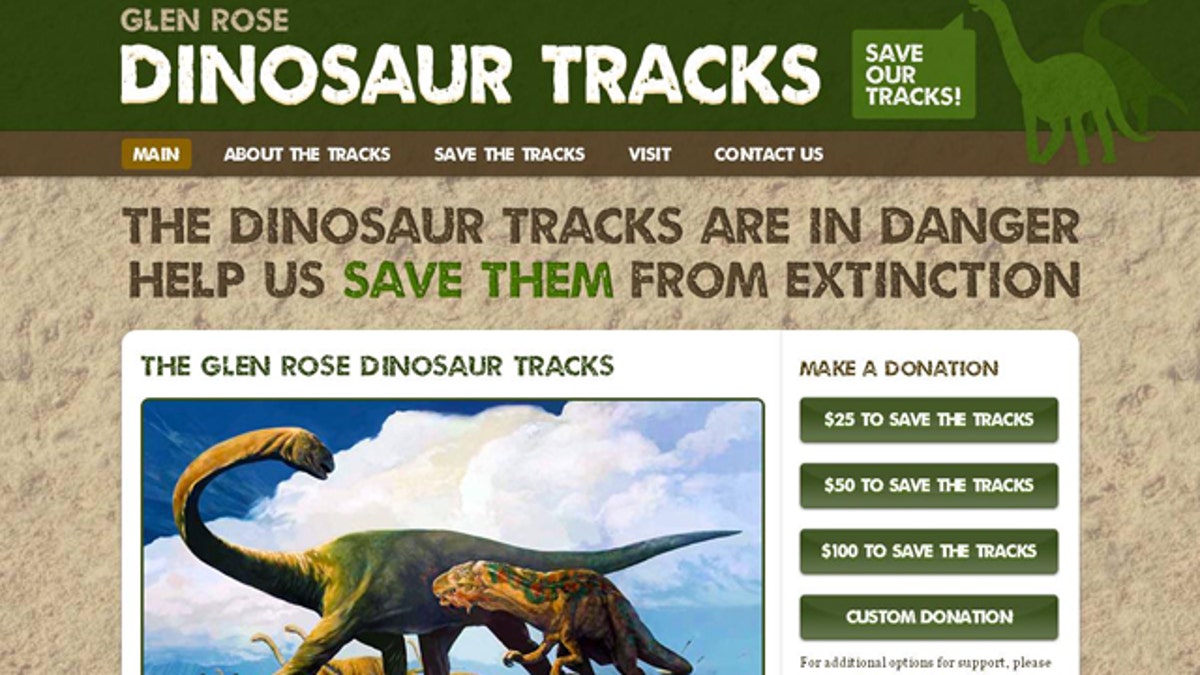
A screenshot of the website for the Glen Rose Dinosaur tracks offers information on the find and how visitors can help protect the ancient footsteps. (savethedinosaurtracks.com)
AUSTIN, Texas – Let's face it: Dinosaurs are old news. So millions of years ago. And therein lies the fascination.
Consider that along an ancient sea near present-day Fort Worth, two behemoth beasts, tipping the scales at a combined 26 tons or so, tramped through coastal mud, leaving enormous tracks -- now celebrated around the world -- and a dinosaur mystery that endures 112 million years later.
Housed in a small building outside the Texas Memorial Museum on the University of Texas campus, the fossilized tracks tell us that one dinosaur, a three-toed meat-eater, stepped inside the footprints of the other, a much larger plant-eater. From the impressions, scientists know they made the prints roughly around the same time.
Was the meat-eater stalking the other? Were they doing a prehistoric Texas two-step?
"We've got just enough of the story to spark a lot of questions," said Ed Theriot, director of the Texas Natural Science Center, which encompasses the museum and research labs and collections at the Pickle Research Campus.
The tracks are gems because they are considered among the best-preserved ever found and because they include the first sauropod (plant-eater) tracks to be documented. But they are deteriorating. A new $1 million science center fundraising campaign aims to save them and move them inside the museum.
Known as the Glen Rose Dinosaur Tracks -- for the present-day location about 40 miles southwest of Fort Worth where they were discovered in 1940 -- the imprints aren't so much showing their age as they are showing the effects of the conditions in which they have been housed for 70 years.
Because the building that contains the tracks isn't air-conditioned, nor suited for their preservation, moisture equivalent to seven gallons of water a day percolates through the trackway rocks, Theriot said. The moisture and fluctuating humidity are weakening the stone, causing flaking and crumbling.
In 2009, experts determined that the tracks lay on a cracked slab of cement that wasn't reinforced and lacked a moisture barrier between the trackway stone and the ground.
"We want to keep it from becoming a catastrophe," Theriot said. "There's obviously problems."
The science center wants "to go Cadillac on this," Theriot said, not just solve short-term problems. If the campaign raises $1 million, the center intends to remove the rocks -- actually, there are some 400 pieces that make up the trackway -- clean the plaster that holds them together and chemically treat, reassemble and move them into a climate-controlled exhibit space inside the museum. There they can be preserved, better seen and used for education, Theriot said.
According to the science center, more than 85,000 people visit the museum's exhibit hall each year, including 40,000 schoolchildren.
In its current location -- a stone building with a small sign -- the roughly 12-by-36-foot trackway can be seen through a glass front wall at about a 30-degree angle for most people, worse for children. Were it not for the sign inside, which briefly tells the dinosaurs' saga, the tracks could appear to be merely dirt holes.
But "you can read that (sign) a hundred times" and not fully appreciate the story the tracks tell -- of the dinosaurs' behavior, their paths, the length of their strides and the size of their tracks, Theriot said. "Between the glare, the diffuse lighting, the angle and the (window) thumbprints and palm prints, you just don't get the impact."
The science center wants to display the tracks at a strongly tilted angle, affording everyone, including children, a better view.
Theriot said he could find no documentation explaining why the current site was chosen but noted that these were among the first sets of tracks of their kind ever found, and there likely was no real practical experience on which to base a decision.
"It would not be unreasonable to assume that footprints safe in the ground for 100 million years would be OK for a long, long time placed on top of the ground and in a covered building," he said.
Debra Warren, who with her sons Brandon, 10, and Logan, 7, traveled recently from Spring Branch to visit the museum, said she didn't know of the Glen Rose exhibit and only stumbled upon it, nor did she know that the tracks were deteriorating. She agreed that having the exhibit inside the museum would allow more people to appreciate the tracks.
"Unless the glass is kept in immaculate condition, you wouldn't get as great a view as you would" in the museum, Warren said.
Still, she and her sons thought the prints were phenomenal.
"It was a pleasant surprise," Warren said.
The prints befit what one would imagine from a sauropod dinosaur that scientists think was about 60 feet long and a therapod that was probably 30 feet long. Their strides were 9 to 10 feet long.
So, was the meat-eater stalking prey?
"The therapod is the predator in this ecosystem, so perhaps it was," said Pamela Owen, a paleontologist with the science center. "You do have that potential interaction because of that small amount of time (when the therapod and the sauropod left the tracks). That's the closest we're really going to get in getting some behavioral information."
